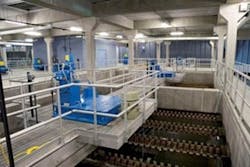The Metropolitan (Metro) Syracuse Wastewater Treatment Plant provides wastewater treatment for approximately 270,000 residents of the City of Syracuse and surrounding communities. The plant is designed to treat an average monthly flow of 84 mgd, with a peak flow of 126 mgd and a hydraulic capacity of 240 mgd.
The Problem
In 1998, Onondaga County signed an amended consent judgment with the State of New York to significantly increase the level of treatment at the Metropolitan Syracuse Wastewater Treatment Plant. Since then, the addition of North America’s largest biological aerated filter system (Biostyr) and the largest tertiary ballasted settling system in the U.S. (Actiflo) has allowed the Metro plant to consistently meet very low effluent ammonia and phosphorus limits. The bundling of Kruger’s Biostyr and Actiflo processes into a combined solution has played a key role in the markedly improved water quality conditions in Onondaga Lake.
The Metro plant is next to Onondaga Lake, and the length of pilings (275 ft) required for construction dictated that the new facilities be as small in size as possible. The Kruger technologies selected for the Metro plant have the smallest footprints of any commercially available alternative and, through extensive competitive trials, were shown to provide the lowest operational costs possible for the high level of post-secondary treatment required.
The Solution
The Biostyr process combines a very high-density fixed-film biological treatment system with filtration, minimizing reactor volume and eliminating the need for final clarifiers. Each of the plant’s 18 Biostyr cells holds 11.5 ft of polystyrene beads held in place by a combination of concrete decking and nozzles. The beads provide a surface area for nitrifying bacteria to grow, and the bacteria converts ammonia to nitrate.
“The Biostyr (BAF) system has consistently reduced our effluent ammonia levels well below permitted levels for years with minimal operations and maintenance effort,” said Jim Jones, head operator at the Metro plant. “The system is highly efficient year-round, even during winter months when average effluent temperatures descend to 9°C or less.”
The Metro plant's Actiflo ballasted flocculation and clarification system has been in service since 2006 and is used to comply with an effluent total phosphorus limit of 0.1 mg/L based on a 12-month rolling average. The treatment plant personnel operate the Actiflo system in a manner that produces an effluent total phosphorus level of 0.08 mg/L or less.
“The Actiflo system packs a great deal of punch in a very small footprint,” said Jones. “We monitor our chemical feed rates and sand concentrations on a daily basis, which allows us to achieve total phosphorus results below design and permit levels. The Actiflo system performs exceptionally at the upper end of design hydraulic and phosphorous loadings, which are often approached at this facility.”
The system consists of four treatment trains. Each is rated at 31.5 mgd and uses microsand as a ballast to greatly increase the settling velocity of the flocculated material. The process employs typical coagulation chemistry along with a polymer to flocculate material and adhere it to the microsand. The system provides a short hydraulic retention time (less than 15 minutes) and high clarifier rise rates (32 gpm/sq ft).
The Metro plant experiences high storm flows during the spring snow-melt season and during rain events throughout the summer and fall. With an average daily flow of approximately 60 mgd, these high flows can reach 126 mgd in a very short period of time. While most treatment plants may see peak flows two or three times a year, the Metro plant can see them two or three times a month. Since the ballast material for the Actiflo system is always inventoried in the process tanks, a treatment train that is offline can be brought into service quickly as the increasing flow rates require. This ability to quickly start and stop treatment trains is critical to consistently meeting a low phosphorus limit.
The benefits of the installation are:
- highly efficient tertiary ammonia removal below 1.0 mg/L in a small footprints;
- extremely low total suspended solids effluent; and
- consistently produces effluent phosphorus levels below 0.08 mg/L.
The Results
Onondaga Lake, once considered to be the most polluted lake in the United States, has seen a steady increase in health since the Metro Syracuse plant upgrades were completed in 2006. Ammonia discharges from the plant have been reduced by nearly 95% compared to pre-upgrade levels, and phosphorus discharges have been reduced by over 85%. The plant is no longer responsible for contributing a majority of all nitrogen and phosphorus discharges into the lake, as it once was, and the bundling of Biostyr and Actiflo in a combined solution has contributed significantly to the resurgence of aquatic species and the drastic improvement in the overall health of the lake.



